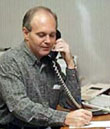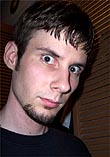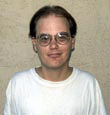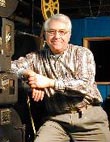|
|
 
|
|
Author
|
Topic: SMART afterburner anomaly.
|
|
|
|
|
|
|
|
|
|
|
Oscar Neundorfer
Master Film Handler

Posts: 275
From: Senoia, GA
Registered: May 2000
|
 posted 04-07-2004 07:00 AM
posted 04-07-2004 07:00 AM





Undesired radio reception such as you are getting usually comes from some non-linearity in the signal path which causes rectification and therefore detection of the radio broadcast with the result that the radio audio gets added to the desired signal. This non-linearity in many cases results from a poor connection such as a loose wire which has some type of corrosion. This can create a diode effect which detects the modulated radio signal.
Also, if a radio signal is strong enough, then the transistors in the IC's can be driven so hard that they overload, also causing a diode action.
Grounding is a big issue in these cases because rf signals can easily get into the electronic equipment due to poor or improper grounding. Shields on audio cables are important for this reason. They can help to keep rf energy from entering if properly used.
I have seen cases where conduit connections were poor and allowed rf to get rectified and somehow sneak into the audio path. When conduit is first installed, all is OK, but eventually the individual pieces of conduit are no longer well connected to each other.
I know of one theater here which has a 50kW AM transmitter out in the parking lot a couple of hundred feet away. I cannot personally verify this, but I was told that every piece of conduit was welded together, and anywhere it contacted other structural metal, it was welded to the metal at that point to eliminate degradation of connections over time. Believe me, the theater is in a VERY strong rf field.
So, check ALL connections, not just on the Afterburner, but throughout the entire rack for tightness. Look carefully at any crimp connections you might have as these can be especially troublesome. Also make absolutely certain that the rack AC ground is intact both at the rack end and at the distribution panel end. I have seen problems in situations where a ground wire coming into the rack was wire-nutted to other ground wires. This is a big no-no. Wire nuts do NOT make good ground connections. Look in the rack AC junction box if there is one, and make certain the AC ground wire is properly terminated to the rack and to the power distribution in the rack.
Try running a ground wire from the Afterburner output ground to the rack ground.
When it comes to rf interference, you need to experiment with all types of things. It can be very tricky to eliminate, but usually it can be dealt with.
If you have another Afterburner in another house, consider temporarily swapping it out to see if the problem goes away. SMART will be happy to send you another Afterburner on a repair/exchange basis if the Afterburner proves to be at fault.
| IP: Logged
|
|
|
|
|
|
Steve Guttag
We forgot the crackers Gromit!!!

Posts: 12814
From: Annapolis, MD
Registered: Dec 1999
|
 posted 06-22-2004 04:16 PM
posted 06-22-2004 04:16 PM




Michael, for good RF suppression, the shielding body needs to be grounded at both ends...unlike for audio supression where traditionally one-end is grounded. Often when one is trying to shield RF and not create ground loops...one end will be connected directly to ground and the other end connected to the ground via a capacitior. This will allow the RF noise to drain but block any low frequency grounding problems.
As to the need/desire for the Afterburner or other dynamic range altering device...
It is NOT a simple matter of turning the volume down or up. There is a practical dynamic range of a theatre. The lower limit is set by the ambient noise of the room with all sources contributed including air handlers and the audience itself. If the recorded sound is below this threshold, then it will be lost as if it was never recorded. Clearly this is not desired.
While better designs in HVAC systems can be done to reduce ambient noise, the audience factor is not as easy to contend with. We sell them popcorn and candy and drinks...those sounds should be tolerated and effectively raise a theatre's noise floor such that most NC-30 theatres never really achieve that once the people are in it unless it is a small screening room without refreshments.
I have long maintained that a better solution would be to generate a random steady-state noise floor to raise a theatre's noise level such that people noises are effectively masked...then either mix films to that level or compress the audio such that the quieter sounds are not lost in the noise.
At the other end of the spectrum are the high levels. Presumming you meet any of the digital soundtrack specifications...each stage speaker and surround channel can be playing up to 103dBc. Add to that the sub channel playing up to 10dB louder and then sum them together and you get a VERY loud theatre.
The limits to this are your system...can your system really handle that much? Next, can your auditorium really contain that much (in multiplexes). If your inter-theatre walls are not built to STC-75 or higher, then the answer is no. Typical theatre construction has demising walls that measure from FSTC-55 to FSTC-65. Odds are, if you play your system at spec, it can be heard in the adjacent auditorium. Note, I've measured walls that are even worse than that. If all you have is a double-stagger stud drywall with insullation between and a couple layers of gyp board on each side...you are maybe at STC-60 depending on other factors. If you want to get to desired STC-75 or better, there better be a masonry septum between the two theatres in addition to the two asymetrical wall systems.
Another important limiting factor on the upper end is the tolerence of the audience to the volume. If it is too loud, it is too loud. I've done enough studio screenings to know that they want the level just too loud for most patrons and even distinquished guests. I've been in the booth when a guest came to the booth screaming to turn it down whilst the studio reps held firm to the level they screened it at and refused a volume change.
So why can't you just turn the volume down? Because you have not changed the dynamic range. You just sent the low level signals into the noise floor and the dialogue to the point it is too soft. Dialogue should sound natural an comfortable. It is one reference point even the layperson can relate to. If you turn the volume down, you turn the dialogue down with it.
With a top-end compressor/limiter you can leave the dialogue where it belongs and only restrict the offensive high level (to the customer or from damaging equipment or coming through the walls).
This is not an endorsement of the SMART product but I do accept the concept of the device. If properly designed and properly installed, such a device could alliviate problems encounted in some film/theatre combinations.
I have been known to use a compressor and frequency band-pass filters on subwoofers only to keep the sub channel from pounding through a poorly designed theatre wall (theatre designed in the 70s...trying to cope with digital soundtracks). The result, you get the subwoofer in the viewing theatre but are not listening to it in the next theatre. Is this as good as having a good wall and tuning everything to spec, of course not but one has to work with the hand they are dealt until such time as the cards are re-dealt.
Steve
| IP: Logged
|
|
|
|
|
|
|
|
|
|
All times are Central (GMT -6:00)
|
|
Powered by Infopop Corporation
UBB.classicTM
6.3.1.2
The Film-Tech Forums are designed for various members related to the cinema industry to express their opinions, viewpoints and testimonials on various products, services and events based upon speculation, personal knowledge and factual information through use, therefore all views represented here allow no liability upon the publishers of this web site and the owners of said views assume no liability for any ill will resulting from these postings. The posts made here are for educational as well as entertainment purposes and as such anyone viewing this portion of the website must accept these views as statements of the author of that opinion
and agrees to release the authors from any and all liability.
|

 Home
Home
 Products
Products
 Store
Store
 Forum
Forum
 Warehouse
Warehouse
 Contact Us
Contact Us




 Printer-friendly view of this topic
Printer-friendly view of this topic












![[Big Grin]](biggrin.gif)




